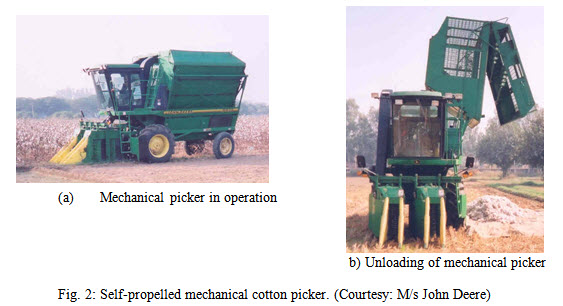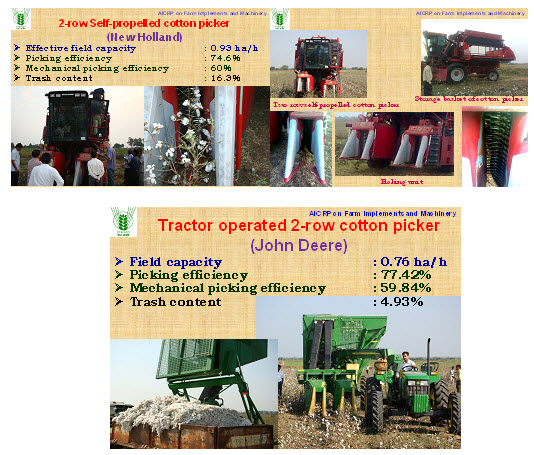Site pages
Current course
Participants
General
MODULE 1. PRINCIPLES AND TYPES OF CUTTING MECHANISM
MODULE 2. CONSTRUCTION AND ADJUSTMENT OF SHEAR AND...
MODULE 3. CROP HARVESTING MACHINERY
MODULE 4. FORAGE HARVESTING, CHOPPING AND HANLING ...
MODULE 5. THRESHING MECHANICS, TYPES OF THRESHES, ...
MODULE 6. MAIZE HARVESTING AND SHELLING EQUIPMENT
MODULE 7. ROOT CROP HARVESTING EQUIPMENT
MODULE 8. COTTON PICKING AND SUGARCANE HARVESTING ...
MODULE 9. PRINCIPLES OF FRUIT HARVESTING TOOLS AND...
MODULE 10. HORTICULTURAL TOOLS AND GADGETS
LESSON 18. COTTON PICKERS, CONSTRUCTION AND WORKING PRINCIPLES
Manual harvesting/picking of cotton is quite labour intensive operation. It requires 2-3 pickings and sometimes even more. Mechanical harvesting of cotton is widely used in USA, Russia, Egypt etc. There are two type of mechanical harvesting equipment popularly known as cotton pickers and strippers. Both these types of machines require the cotton variety with compact sympodial or semi-sympodial plants with synchronized boll opening.
Mechanical Pickers: The cotton picker performs the work of hand picker in that only the locks of seed cotton are removed from the plant. There are four ways of classifying cotton pickers. They are by method of mounting, by number of rows harvested, by height of picking drums and by type of spindle used. It can be tractor mounted machine (Fig. 1) or self-propelled (Fig. 2) of one or two-rows. In this, the cottonseed is removed from open bolls; whereas, green and unopened bolls are left on the plant to mature for later picking. A mechanical picker consists of a device to guide cotton plants to come into picker, device to remove cottonseed from open bolls; a conveying system for picked cotton and a storage basket. These machines should be capable of gathering mature cotton with a minimum of waste and without causing serious damage to the fiber plant and unopened bolls. The high yielding, long fibers and open-boll varieties of cotton are defoliated before the first picking.
Functional components of a mechanical picker
Following are the basic components of a mechanical picker
i) An arrangement for guiding the plants into the picking zone and providing necessary support while the seed cotton is being removed.
ii) Devices to remove the cotton from open bolls.
iii) A conveying system for picked cotton
iv) A storage basket or a container in which picked when is stored temporarily.
Spindles: The basic principle of a revolving spindle penetrating the cotton plant, winding the seed cotton from the open boll and retreating to a doffing zone is employed by all commercial pickers. The rearward movement of the spindles while in the picking zone is substantially the same as the forward movement of the machine so that the spindles do not move forward or backward with respect to the cotton plant. Each rotating spindle merely probes straight into the cotton plant from the side of the row, works on an open boll and then withdraws straight to the side with a minimum disturbance and damage to the remaining plant. The spacing of spindles (1½ x 1½) is such that they can slip past unopened boll and leave them onto the plant to mature for a later picking.
Drum type spindle arrangement: The mechanical cotton pickers have either tapered spindles or small-diameter straight spindles. Spindles are carried either on bars arranged in vertical drums or on vertical slats attached to endless chain. Tapered spindles, commonly employed on drum-type pickers, have 3 or 4 longitudinal rows of sharp barbs for engaging the cotton bolls. Tapered, barbed spindles enter the plant perpendicular to row and wound the exposed lint on the berbs. As the spindles passes slowly, faster rotating rubber-faced buffers remove lint. Speed of spindle varies from 1850 rpm at forward speed of 2.9 km/h to 3250 rpm at 5.0 km/h. Speed of spindle influences the picking efficiency for fluffy bolls and increases from 80% at 700 rpm to 95% at 2300 rpm. The loss at higher speed is mainly due to cotton thrown by spindles and loss at lower speed is mainly due cotton left in burs. Straight spindles are longer than tapered type but smaller in diameter. They may be round or square and may have smooth or rough surface. In general, picking ability of pickers depends upon the spindles being wet when they come in contact with cotton. A stationary cam and followers on the bar achieve the proper orientation of spindle bars in relation to crop row. The two drum picks up from the two sides of the row in succession spring loaded adjustable pressure plate opposite each drum crowds, the plants towards the spindle in the picking zone. In current high drum machines the front drum has 15 or 16 spindles bar and rear drum has 13 or 12 bars, with 20 spindle per bar. This gives a total of 560 spindles per row of cotton, each spindle requiring a precession fit sleeve bearing and being driven through the bevel gear by a shaft inside the spindle bar. They are suitable for low growing or medium height cotton. The proper orientation on the spindle bar in relation to row is obtained by means of a stationary cam and a follower in the bar.
Chain belt spindle arrangement: The picking process with a chain belt unit is essentially the same as with the drum type picker although the chain belt principle permits the spindle to remain in picking zone for a longer time. The spindle is normally straight. The standard-height-picking unit has 80 vertical slats each with 16 spindles. High units have 22 spindles per bar. Each spindle is rotated by means of a roller in contact with a stationary, rubber drive rail, but only while on the picking side of unit. Guide strip hold the chain in position between the main sprockets and provide a curvature for moving the spindles laterally into and out of row. Each slat is pivoted between the upper and lower chains. While the spindles are being rotated, the action on the drive rails maintains the spindle in a position normal to curvature of the drive rails.
Spindle moistening: Spindle of either type are moistened with waters for two reasons:
a) As an aid in picking because of cotton adheres better to a wet steel surface.
b) To keep spindle clean as some gummy substances stick while these are in picking unit. Some wetting agents are also used which reduces the amount of water required for moistening and at the same time makes it more effective.
A spindle moistening system is provided for each picking unit, water being metered in equal amount to each spindle. Application is made to each spindle just before it enters the taking zone, by means of a specially designed rubber wiping pad. Water is applied to each spindle just before entering the picking zone by means of a specially designed rubber-wiping pad. The seed cotton is removed from spindles by means of rotating doffer plates. The clearance between surface of spindle and rubber lugs on the doffer should be 0.25-0.75 mm. A pneumatic conveying system is used to move the cotton from the doffing area to storage basket on the picker. The cotton is blown through the discharge ducts against cleaning grates in the basket lid and during this process some of the trash from seed cotton is removed.
Removal of cotton from the spindle: On machine with tapered spindle, the seed cotton is removed from the spindle by means of rotating doffer plates. The cotton is forced off as the dogger lug moves over the spindle surface toward the tip. With small diameter straight spindles stripping is accomplished by moving the spindles axially through the space between the closely fitted stripper shoes. Tapered spindles are rotating when doffed, whereas small diameter straight spindles are not.
Conveying and carrying: A pneumatic conveying system is used to move the cotton from the doffing area to storage container. The cotton is blown through the discharge duct against cleaning grate in the storage basket lid. This action removes some of the trash from the seed cotton. Machine with dual picking unit have 2 separate elevating systems to provide more uniform and positive conveying from each unit. Some machine use off set arrangement to eliminate contact between the cotton and the fan blades. Storage basket is ordinarily carried on picker with capacities generally in the range of 900 to 1300 lbs for single row machine and 2000 to 3300 lbs for 2 row units. Basket is emptied by with hydraulic cylinder.


Performance of cotton pickers: There are many factors that affect the performance of cotton pickers. Cotton pickers perform best when cotton plants are of medium size. Medium-sized plants flow through the machine and permit the spindles to engage the cotton better than large plants with many long limbs. The machine requires a well-opened boll with locks that are fluffy and fiber that is long enough to wrap around the spindle. Chemical defoliation is generally done before the picking operation, which helps the simultaneous opening of most of the cotton bolls. A delay in picking and early opening of cotton boll result in atmospheric damage to the exposed cotton fiber. A slight elevation of the soil at the base of plant and weed-free fields are essential for better performance of cotton pickers. Fairly thick and uniform spaced plants aid the performance of mechanical cotton picker.
Manually-operated Cotton Picker: Manually operated cotton picker using an endless chain with picking fingers has also been developed. The device is carried by operator and can remove 90-95% of cotton lint. As much as 2% of cotton lint is dropped on the ground. It can pick up to 18 kg/h of cotton lint with trash content of 18.5%.